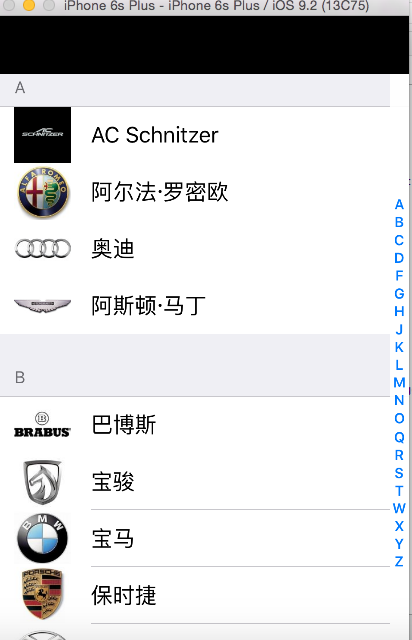多个模型 在 tableview
2016-03-22 16:13
435 查看

MJCar.h
import
import “MJCar.h”
@implementation MJCar+ (instancetype)carWithDict:(NSDictionary *)dict
{
return [[self alloc] initWithDict:dict];
}
(instancetype)initWithDict:(NSDictionary *)dict
{
if (self = [super init]) {
[self setValuesForKeysWithDictionary:dict];
}
return self;
}
@end
MJCarGroup.h
import
import “MJCarGroup.h”
import “MJCar.h”
@implementation MJCarGroup+ (instancetype)groupWithDict:(NSDictionary *)dict
{
return [[self alloc] initWithDict:dict];
}
(instancetype)initWithDict:(NSDictionary *)dict
{
if (self = [super init]) {
// 赋值标题
self.title = dict[@”title”];
// 取出原来的字典数组
NSArray *dictArray = dict[@"cars"];
NSMutableArray *carArray = [NSMutableArray array];
for (NSDictionary *dict in dictArray) {
MJCar *car = [MJCar carWithDict:dict];
[carArray addObject:car];
}
self.cars = carArray;}
return self;
}
@end
MJViewController.h
import
import “MJViewController.h”
import “MJCarGroup.h”
import “MJCar.h”
@interface MJViewController ()/**
* 车品牌组数据
*/
@property (nonatomic, strong) NSArray *groups;
@end
@implementation MJViewController
(void)viewDidLoad
{
[super viewDidLoad];
// Do any additional setup after loading the view, typically from a nib.
}
(NSArray *)groups
{
if (_groups == nil) {
// 初始化
// 1.获得plist的全路径
NSString *path = [[NSBundle mainBundle] pathForResource:@”cars_total.plist” ofType:nil];
// 2.加载数组
NSArray *dictArray = [NSArray arrayWithContentsOfFile:path];
// 3.将dictArray里面的所有字典转成模型对象,放到新的数组中
NSMutableArray *groupArray = [NSMutableArray array];
for (NSDictionary *dict in dictArray) {
// 3.1.创建模型对象
MJCarGroup *group = [MJCarGroup groupWithDict:dict];
// 3.2.添加模型对象到数组中
[groupArray addObject:group];
}
// 4.赋值
_groups = groupArray;}
return _groups;
}
pragma mark - 数据源方法
(NSInteger)numberOfSectionsInTableView:(UITableView *)tableView{
return self.groups.count;
}
(NSInteger)tableView:(UITableView *)tableView numberOfRowsInSection:(NSInteger)section
{
MJCarGroup *group = self.groups[section];
return group.cars.count;
}
(UITableViewCell )tableView:(UITableView )tableView cellForRowAtIndexPath:(NSIndexPath *)indexPath
{
// 1.定义一个循环标识
static NSString *ID = @”car”;
// 2.从缓存池中取出可循环利用cell
UITableViewCell *cell = [tableView dequeueReusableCellWithIdentifier:ID];
// 3.缓存池中没有可循环利用的cell
if (cell == nil) {
cell = [[UITableViewCell alloc] initWithStyle:UITableViewCellStyleDefault reuseIdentifier:ID];
}
// 4.设置数据
MJCarGroup *group = self.groups[indexPath.section];
MJCar *car = group.cars[indexPath.row];
cell.imageView.image = [UIImage imageNamed:car.icon];
cell.textLabel.text = car.name;
return cell;
}
/**
* 第section组显示的头部标题
*/
- (NSString )tableView:(UITableView )tableView titleForHeaderInSection:(NSInteger)section
{
MJCarGroup *group = self.groups[section];
return group.title;
}
/**
* 返回右边索引条显示的字符串数据
*/
- (NSArray )sectionIndexTitlesForTableView:(UITableView )tableView
{
return [self.groups valueForKeyPath:@”title”];
}
(BOOL)prefersStatusBarHidden
{
return YES;
}
@end
注意点:需要加入plist文件
不要写description,官方用了
相关文章推荐
- 峰回路转,Firefox 浏览器即将重返 iOS 平台
- 峰回路转,Firefox 浏览器即将重返 iOS 平台
- 不可修补的 iOS 漏洞可能导致 iPhone 4s 到 iPhone X 永久越狱
- iOS 12.4 系统遭黑客破解,漏洞危及数百万用户
- 每日安全资讯:NSO,一家专业入侵 iPhone 的神秘公司
- [转][源代码]Comex公布JailbreakMe 3.0源代码
- 讲解iOS开发中基本的定位功能实现
- iOS中定位当前位置坐标及转换为火星坐标的方法
- js判断客户端是iOS还是Android等移动终端的方法
- iOS应用中UISearchDisplayController搜索效果的用法
- IOS开发环境windows化攻略
- iOS应用中UITableView左滑自定义选项及批量删除的实现
- 浅析iOS应用开发中线程间的通信与线程安全问题
- 检测iOS设备是否越狱的方法
- .net平台推送ios消息的实现方法
- 探讨Android与iOS,我们将何去何从?
- Android、iOS和Windows Phone中的推送技术详解
- iOS推送的那些事
